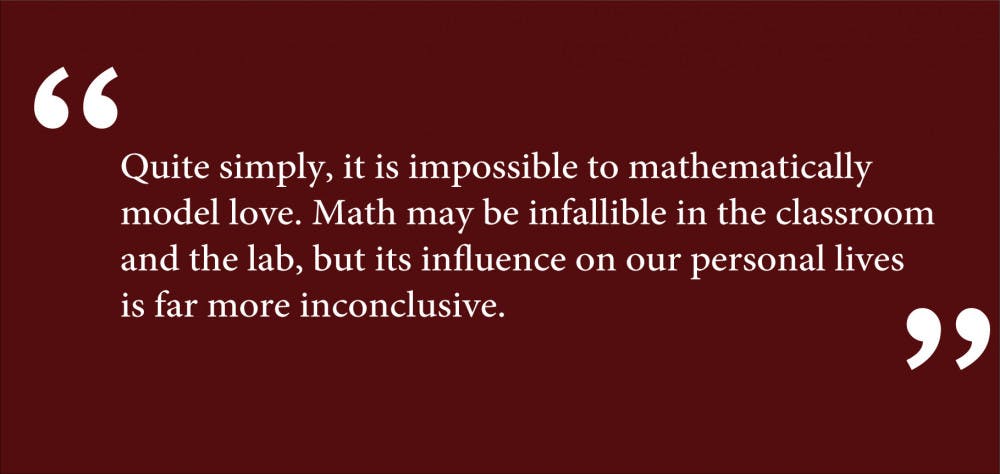Math dictates almost every process in our lives: It can determine if an infectious disease will become an epidemic, how quickly a biochemical system will reach its equilibrium and the circumstances under which a certain species will become extinct. However, though I am firm in my conviction that math is the single most important system of thought discovered on our planet, I don’t think it has any place in human romantic interactions.
Recently, the Blognonian paired with the Harvard Computer Society to bring to Brown an edition of Datamatch — a matchmaking service in which over 60 percent of Harvard’s campus participates, according to its organizers. The premise of Datamatch is to use mathematical algorithms to assign students their “perfect match.” Though math can account for an infinite number of phenomena, how can it perfectly predict interpersonal chemistry? More importantly, should we aim to improve artificial intelligence to the point that it can assign us our “perfect match?”
“Black Mirror,” a British television series proudly touted by Netflix, often depicts dystopias in which technology rules all interpersonal interactions. In the series’ most recent season, the episode “Hang the DJ” highlights what romantic and sexual exploration would look like if every participant had a device that could predict the outcomes of their potential relationships. The data compiled from one’s series of relationships — that could last hours or years — ultimately promised to lead the users to their 100 percent match: in other words, their soulmate.
As millennials, we have been indulged by instant gratification: Instagram “likes” immediately invalidate our insecurities, and Facebook reactions remind us that we have online communities that support our ideas and pursuits. The most dangerous factors to consider, when contemplating systems such as Datamatch, are the instant gratification and the false sense of certainty they provide us. Why endure the “ghosting,” the ignored texts, the meaningless hookups, the heartbreak and emotional torment that the pursuit of love often entails when we can answer tangential questions such as “Why do you take classes S/NC?” and be delivered our “perfect match?” The simplicity of the question above (provided by Datamatch) is not universal across all dating applications, but the underlying fallacy remains blatantly clear: No data can truly predict the chemistry between two (or more) individuals.
A fundamental element in solving most mathematical proofs is the “if and only if” statement. In using this step to prove a conclusion, we must prove that event A causes event B and vice versa. In this case, can we prove that if we participate in mathematically-founded systems such as Datamatch, we will find our “perfect match?” If we find our “perfect match,” will it be a result of participation in Datamatch’s services?
When I was growing up, my mom always told me “opposites attract.” Maybe this was to justify that she, the woman who becomes friends with every cashier at Stop and Shop, married my father, who wears soundproof headphones around the house to avoid conversation. Some couples, regardless of sexual orientation or identity, prefer to be with those who share identical characteristics, whereas some want to be with those who supply the very characteristics they lack. How can we rely on algorithms and internet applications to dictate what is “perfect” for us when we ourselves often don’t know what we’re looking for in a relationship until it’s right in front of us?
The theorems of Pythagoras and the methods of Euler and Newton have maintained their immutability as universal truths since their logical conceptions. However, in a time when our world is constantly being shattered and glued back together by technological and social processes, it is impossible for human interactions to not be impacted by temporal circumstances.
Furthermore, even if we were to live in a vacuum untouched by scientific, technological and social advancements, math still would be unable to assign us our “perfect match.” In Oscar E. Fernandez’s “The Calculus of Happiness: How a Mathematical Approach to Life Adds Up to Health, Wealth and Love,” the mathematician and Wellesley College professor attempts to estimate N, the maximum number of potential partners one could possibly have based on a number of variables: P represents the population from which you would like to find your partner, S is the fraction of the population of the desired sex, A the fraction within the desired age range, E the fraction within the stratum of desired educational attainment, D the fraction that is available, H1 the fraction you would want to date and finally, H2 representing the fraction who would date you.
N=(P)(S)(A)(E)(D)(H1)(H2)
The product of all of the variables above is supposed to give a rough estimate of the potential number of partners who could be a “perfect match.” I would like to elaborate on Fernandez’s equation to accommodate sexual preferences and orientations within the two last variables. Even if this equation were to work perfectly, however, it does not account for an individual’s sexual and romantic preferences (of which there are an infinite number) and how they are weighted. It’s impossible to quantify how much it means when your partner gets along with your parents, how they care for you when you are sick or whether they help you with your problem sets. Quite simply, it is impossible to mathematically model love. Math may be infallible in the classroom and the lab, but its influence on our personal lives is far more inconclusive.
Nikki Kaufmann ’18 is an applied mathematics concentrator and can be reached at nicole_kaufmann@brown.edu. Please send responses to this opinion to letters@browndailyherald.com and op-eds to opinions@browndailyherald.com.





